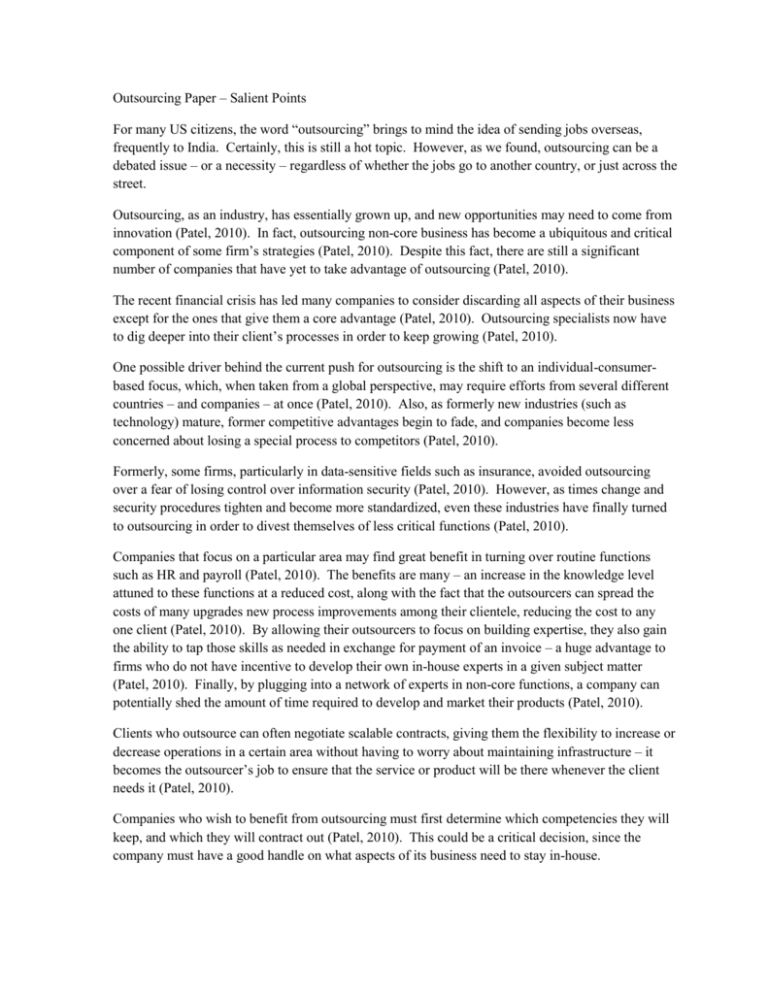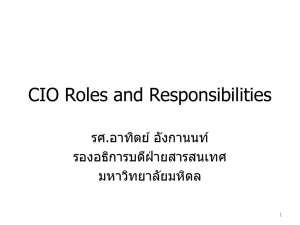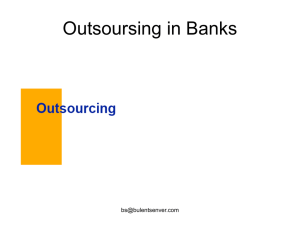Outsourcing Paper – Salient Points - FedEx-Vs-UPS
advertisement

Outsourcing Paper – Salient Points For many US citizens, the word “outsourcing” brings to mind the idea of sending jobs overseas, frequently to India. Certainly, this is still a hot topic. However, as we found, outsourcing can be a debated issue – or a necessity – regardless of whether the jobs go to another country, or just across the street. Outsourcing, as an industry, has essentially grown up, and new opportunities may need to come from innovation (Patel, 2010). In fact, outsourcing non-core business has become a ubiquitous and critical component of some firm’s strategies (Patel, 2010). Despite this fact, there are still a significant number of companies that have yet to take advantage of outsourcing (Patel, 2010). The recent financial crisis has led many companies to consider discarding all aspects of their business except for the ones that give them a core advantage (Patel, 2010). Outsourcing specialists now have to dig deeper into their client’s processes in order to keep growing (Patel, 2010). One possible driver behind the current push for outsourcing is the shift to an individual-consumerbased focus, which, when taken from a global perspective, may require efforts from several different countries – and companies – at once (Patel, 2010). Also, as formerly new industries (such as technology) mature, former competitive advantages begin to fade, and companies become less concerned about losing a special process to competitors (Patel, 2010). Formerly, some firms, particularly in data-sensitive fields such as insurance, avoided outsourcing over a fear of losing control over information security (Patel, 2010). However, as times change and security procedures tighten and become more standardized, even these industries have finally turned to outsourcing in order to divest themselves of less critical functions (Patel, 2010). Companies that focus on a particular area may find great benefit in turning over routine functions such as HR and payroll (Patel, 2010). The benefits are many – an increase in the knowledge level attuned to these functions at a reduced cost, along with the fact that the outsourcers can spread the costs of many upgrades new process improvements among their clientele, reducing the cost to any one client (Patel, 2010). By allowing their outsourcers to focus on building expertise, they also gain the ability to tap those skills as needed in exchange for payment of an invoice – a huge advantage to firms who do not have incentive to develop their own in-house experts in a given subject matter (Patel, 2010). Finally, by plugging into a network of experts in non-core functions, a company can potentially shed the amount of time required to develop and market their products (Patel, 2010). Clients who outsource can often negotiate scalable contracts, giving them the flexibility to increase or decrease operations in a certain area without having to worry about maintaining infrastructure – it becomes the outsourcer’s job to ensure that the service or product will be there whenever the client needs it (Patel, 2010). Companies who wish to benefit from outsourcing must first determine which competencies they will keep, and which they will contract out (Patel, 2010). This could be a critical decision, since the company must have a good handle on what aspects of its business need to stay in-house. Offshoring, or the practice of sending certain business functions overseas in order to gain access to certain competitive advantages (such as inexpensive labor) is often limited in the minds of many managers to whatever work can be easily documented and explained (Srikanth & Puranam, 2010). However, this view may be too narrowly focused on up-front communications on how to do a series of tasks (Srikanth & Puranam, 2010). Companies that instead seek to improve their overall communications with their outsourcers, even to the level of enabling them to innovate exactly how tasks will be done, tend to see up to four times the benefits from outsourcing as their counterparts (Srikanth & Puranam, 2010). With a greater emphasis on teamwork, companies may also find that they are able to consider sending even more non-core operations overseas (Srikanth & Puranam, 2010). As emerging nations such as China gain skill at critical technologies, such an attitude could lead a company to get a jump on inexpensive and high-quality work (Srikanth & Puranam, 2010). Companies who currently outsource should ask themselves five questions to determine whether or not they need to increase collaboration: 1. Is the offshore operation lagging behind expectations? 2. Has the company focused primarily on creating specific instructions for the offshore vendors? 3. Are there noticeable communication barriers in regards to email and spoken conversations? 4. Does the vendor’s education and training levels vary greatly from the main corporation’s? 5. Can the company achieve an advantage by allowing a certain level of intellectual functionality offshore? (Srikanth & Puranam, 2010) If the company answers yes to any of these questions, it might benefit from an increase in overall collaboration, as opposed to simply refinement of a particular set of instructions (Srikanth & Puranam, 2010). Generally, it is not knowledge transfer but the quality of teamwork that drives success in outsourced projects (Srikanth & Puranam, 2010). This has the greatest benefit when the company is passing along functions that require a certain level of subjective information (Srikanth & Puranam, 2010). Part of the solution involves simply making it easier for the two companies to meet via email or phone, although this can have costs associated with it as well (Srikanth & Puranam, 2010). As Indian firms find growth rates from outsourcing contracts shrinking, they are attempting to move even deeper into their client’s infrastructures – and possibly even become the infrastructure (Sharma & Worthen, 2009). When India still represented an inexpensive solution to one-off problems and the industry was new, growth rates of 30% were seen. Now, between increased competition and a worldwide recession, Indian companies have watched their overall margins shrink to around 4 – 7% (Sharma & Worthen, 2009). Despite the corresponding drop in profit margins, Indian firms have responded by taking on more and more work for their clients. This gives them the chance to jump on the cloud computing bandwagon, which has become increasingly popular (Sharma & Worthen, 2009). In order to manage this, the firms would have to invest in considerably more hardware and infrastructure, the better to support full external data centers or full-service solutions (Sharma & Worthen, 2009). Outsourcing has been good to India – as of 2009, technology services pulled about $58.8 billion into the country, padding them slightly from the recession (Sharma & Worthen, 2009). India still has not achieved a reputation of top-quality, however, and may need to change this in order to return to their days of high growth (Sharma & Worthen, 2009). India will have to fight harder to maintain its status as a primary tech outpost – even less expensive solutions have emerged from Vietnam and the Philippines, creating pressure on India to innovate something different (Sharma & Worthen, 2009). On top of this, firms worldwide are clamping down in IT spending, increasing the competitiveness of the market (Sharma & Worthen, 2009). Another challenge to becoming a full-service solution is the need for Indian firms to gain access to additional expertise, often in areas that have less to do with technology, such as finance, telecommunications, and pharmaceuticals (Sharma & Worthen, 2009). Companies in India also will need to move outside their comfort zone when they go from being pureservice organizations to ones that invest heavily in equipment and provide support for any and all issues (Sharma & Worthen, 2009). This also comes with lowered profit margins and for some, the need to increase internal knowledge and skills through acquisitions (Sharma & Worthen, 2009). Worse, even as they increase their reputation as full-service providers, their ability to do so cheaply may never be recovered (Sharma & Worthen, 2009). Group notes – in this article (Advice for Outsourcers), there are also some good examples of success stories. Success stories are still in the beginning phases – India has yet to see whether or not this shift in strategy from call centers to full-service will pay off (Sharma & Worthen, 2009). For hybrid broker-dealers, failing to outsource non-core aspects of their business could even prove fatal (Coyle, 2010). StillPoint Wealth Management and US Fiduciary came out of the starting gate strong and early with all systems in-house, but eventually collapsed under their own weight (Coyle, 2010). These companies illustrate the dangers of adding too much expensive infrastructure that cannot be supported through daily sales (Coyle, 2010). For these investment firms, outsourcing provides the ability to spread risk to their partners, who can better handle certain types of financing. Every broker-dealer has certain important offerings that can easily be outsourced (Coyle, 2010). The area of research and development brings with it special considerations, because some companies will not want the security risks that come along with sending work to another firm. Generally, there are four good reasons to outsource one’s R&D: 1. When companies would need to add lots of new knowledge to innovate, such as figuring out how to work with an unfamiliar chemical compound to make a different line of pharmaceuticals. 2. In the early stages of a project, when there are lots of technical hurdles to be overcome and the outcome is far from certain. 3. When intellectual property isn't well protected in the industry. In these cases, since new ideas spread quickly from company to company, it may not be possible to differentiate products with innovations. So, businesses turn to outsourcing to limit spending. 4. When companies have had lots of experience with outsourcing. Let's say all the factors above are equal—it's basically a toss-up between working on a project in-house and outsourcing it. In these cases, companies with a long track record of contracting tend to hand off the job to outsiders—three times as often, in fact, as businesses with average levels of experience in the practice. The costs and benefits of outsourcing are more certain for experienced firms, and they can better manage the situation to produce effective results. (Stanko, Bohlmann, & Calantone, 2009) Outsourcing needs to be balanced carefully so that it provides the firm with the greatest amount of benefit. Excessive outsourcing can actually be more costly than internal development, because it is so difficult to maintain control over third parties and because some companies may lose control over the process (Stanko, Bohlmann, & Calantone, 2009). Another problem that comes from losing control is the danger that a patent winds up as a generic product because of demand by the outsourcer’s other clients (Stanko, Bohlmann, & Calantone, 2009). A relatively narrow margin exists for balanced R&D outsourcing. Deviations as small as 1% from the optimal balance can lead to 11% reductions in patent efficiency (Stanko, Bohlmann, & Calantone, 2009). Timing can be another critical issue – companies that move towards outsourcing too late in the process may find that vendors spend precious time relearning the process (Stanko, Bohlmann, & Calantone, 2009). One major benefit of outsourcing R&D arises from scalability – companies can invest lightly in a great number of optional technologies (such as the car industry experimenting with alternate fuel sources) without having to sink too much into any one experiment (Stanko, Bohlmann, & Calantone, 2009). Even the US space program is considering the solution, pursuant to an as-yet-unapproved plan to outsource the development and launching of space-related equipment to private funders such as corporations (Pasztor, White House Decides to Outsource NASA Work, 2010). The stated purpose behind the outsourcing is that by sending this expensive but now routine task outside of NASA, the US government can focus on more intensive, groundbreaking projects (Pasztor, White House Decides to Outsource NASA Work, 2010). If it went as planned, the new program would allot billions of dollars to any company willing to compete, hopefully driving the long-term value up while decreasing costs (Pasztor, White House Decides to Outsource NASA Work, 2010). Major opposition can be found within NASA itself. Some complain that the plan carries too much risk (Pasztor, White House Decides to Outsource NASA Work, 2010). As an illustration of how insufficient funding can lead to problems, NASA is already having trouble with its Ares 1 rocket, designed for human space travel, which has already shot past its original budget of $4.3 billion with at least 2/3 of its development still ahead (Pasztor, White House Decides to Outsource NASA Work, 2010). Not only would the outsourcing proposition threaten the financial health of the Ares 1, but it might also foretell of even worse budget overruns under private contractors who have little or no experience planning multi-billion dollar projects (Pasztor, White House Decides to Outsource NASA Work, 2010). The NASA example also shows an extreme example of how the decision to outsource nearly always carries opportunity costs and risk. In order to allocate sufficient funds to third parties, the government will be forced to close down other, more stable, programs (Pasztor, White House Decides to Outsource NASA Work, 2010). Safety is another possible reason that the idea may ultimately be abandoned (Pasztor, Panel Warns NASA About Outsourcing Risks, 2010). Just Jane’s thoughts: If they do successfully outsource the projects, they might be able to get some of the outsourcers to eat some of the costs involved. Also, once you have a trained a number of companies to provide these types of services, efficiencies can evolve, the price is driven down and it becomes less expensive. This may actually be one of the unstated goals behind the idea – move it away from a single governmental program, and onto the to-do lists of certain major US corporations. As soon as prices drop enough, profits become possible, and then NASA can significantly reduce or eliminate its financial involvement, thus neatly divesting itself of a function where most of the challenges have been met. Complaints came quickly from the Aerospace Safety Advisory Panel, an outside safety watchdog for the National Aeronautics and Space Administration. They are concerned that private companies might not do enough research into the safety aspects of space travel (Pasztor, Panel Warns NASA About Outsourcing Risks, 2010). Their recommendation was that the attempt to outsource space technologies would result in cost inefficiencies, if not danger (Pasztor, Panel Warns NASA About Outsourcing Risks, 2010). President Obama is behind the drive to outsource, but so is a former chairman of Lockheed-Martin (Pasztor, Panel Warns NASA About Outsourcing Risks, 2010). The panel headed by the former chair suggested that the US would benefit from allowing companies such as the new Space Exploration Technologies and the established Orbital Sciences Corp the ability to compete. However, the panel failed to bring specifics into their recommendations (Pasztor, Panel Warns NASA About Outsourcing Risks, 2010). Not everybody left at Lockheed Martin or their main aerospace competitor Boeing is thrilled to hear of the idea. These companies are already being used heavily for various types of governmental outsourcing, and have been fighting the initiative that could add competition (Pasztor, Panel Warns NASA About Outsourcing Risks, 2010). Their points include the fact that some of the newer companies are proposing to use engines and rockets that have yet to emerge from the experimental stages (Pasztor, Panel Warns NASA About Outsourcing Risks, 2010). In fact, the safety panel concluded that none of the companies who would stand to benefit from the new proposal are currently acceptable candidates (Pasztor, Panel Warns NASA About Outsourcing Risks, 2010). Furthermore, some feel that NASA’s attitude towards the safety of manned spaceflight is too lax for comfort (Pasztor, Panel Warns NASA About Outsourcing Risks, 2010). Works Cited Coyle, T. (2010, March 24). New Firms Say Outsourcing Crucial to Survival. Wall Street Journal . Pasztor, A. (2010, January 19). Panel Warns NASA About Outsourcing Risks. Wall Street Journal . Pasztor, A. (2010, January 24). White House Decides to Outsource NASA Work. Wall Street Journal . Patel, D. J. (2010, March 30). The Virtualization of Businesses: Controlling More With Less. Wall Street Journal . Sharma, A., & Worthen, B. (2009, October 6). Indian Tech Outsourcers Aim to Widen Contracts. Wall Street Journal . Srikanth, K., & Puranam, P. (2010, January 25). Advice for Outsourcers: Think Bigger. Wall Street Jouranl . Stanko, M. A., Bohlmann, J. D., & Calantone, R. J. (2009, November 30). Outsourcing Innovation. Wall Street Journal .









